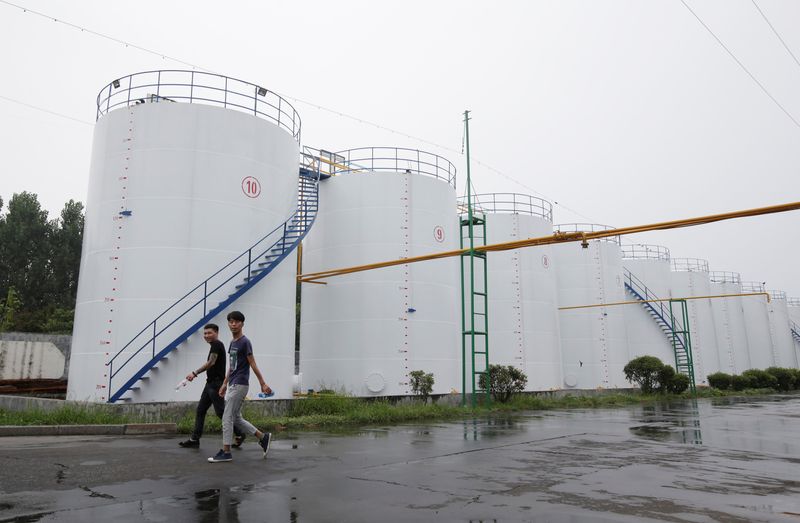By Muyu Xu
SINGAPORE (Reuters) -China's army of small, privately owned oil refiners are raising output on hopes of recovering fuel demand as COVID-19 curbs ease and refining margins swell due to an increasing supply of cheap Russian oil, traders and analysts said.
Higher demand from the world's largest crude oil importer at a time of tight supply is likely to have far-reaching market consequences, including displacing shipments from West Africa and Brazil as well as boosting Russian earnings even as Europe and the United States impose sanctions for attacking Ukraine.
The refiners, or teapots, tend to lack credit needed for long-term contracts with suppliers, leaving them reliant on the spot market for purchases and sensitive to near-term margins.
This makes them a volatile segment of China's refining sector but, accounting for over 20% of crude imports, they are capable of exacerbating swings in the country's market impact.
Teapot purchases fell more than 31% in January-May from the same period a year prior, showed data from analytics firm Kpler, as COVID-19 containment measures subdued domestic fuel use.
With economic stimulus and easing travel curbs, analysts said teapots are set for a turnaround, pouncing on Russian crude trading at steep discounts to international benchmarks as others snub the sanctioned nation in search of supplies elsewhere.
"There is no doubt that teapots will maximise cheap Russian crude purchases because profit is their sole consideration," a Singapore-based oil trader said.
Russian crude ESPO and Urals are roughly $10 a barrel cheaper than Middle East's Oman, cutting teapots' costs and so boosting profitability, another trader said.
SHANGONG FACTOR
Data about individual refiners is rarely made public, but as most teapots are based in Shandong, imports into that eastern province are often used as a proxy for overall teapot demand.
Shandong made up 11.6% of China's crude oil imports in 2015, Kpler data showed, the year the government allowed teapots to directly import crude. Since 2016, its share has averaged 27%.
Its 31% slump in January-May versus China's overall 9.3% decline points to the speed at which teapots cut imports when COVID-19 restrictions hit compared with larger, state-run refiners elsewhere, and indicates room for a potential rebound.
Shandong imported 1.68 million barrels per day (bpd) of crude oil in January-May, or 19.8% of China's total, versus 2.56 million bpd or 26.3% in the same period of 2021, Kpler data showed.
Over 2017-2021, Shandong's June imports averaged 2.22 million bpd. A return to that average would increase imports this month by over half a million bpd.
RUN RATES
China has been one of the largest buyers of Russian oil this year, even as Europe and the United States sanction Russian energy products in response to Russia's invasion of Ukraine. Russia calls its actions in Ukraine a "special operation".
China has expressed concern for the conflict but does not support sanctions on Russia.
"We estimate that China can easily add another 1 million bpd of Russian crude to its diet," J.P. Morgan analysts wrote in a June 1 note to clients.
Wood Mackenzie analyst Daphne Ho said Russia will need to divert about 2.5 million bpd of crude from Europe by the end of 2022, with China a viable destination.
While it is hard to forecast how much more Russian crude China can buy, traders expect China to hike refining throughput by 1.4 million to 2 million bpd if China fully eases COVID-19 restrictions and oil demand bounces back to pre-pandemic levels.
Teapots may raise utilisation rates to about 70% by the end of June from around 60% in late May, a second Singapore-based trader estimated, adding state-owned firms have gradually resumed oil product purchases from teapots.
A 10 percentage point rise would imply additional imports of about 300,000 bpd.
The average teapot refinery run rate rebounded to 64% last week, after slipping under 50% in April, the lowest since March 2020, showed data from Shandong-based consultancy Longzhong.
However, high stockpiles of crude and refined products may limit imports over the near term. Data from analytics firm Vortexa indicated onshore commercial crude oil stocks reached nine-month highs of over 900 million barrels as of late May, near an all-time high of 1 billion barrels in August 2020.
To ease the glut, the government issued 4.5 million tonnes of extra fuel export quotas last week, but higher local fuel demand will be needed to clear the surplus and justify stepped-up imports, traders said.
